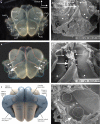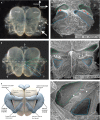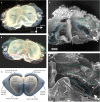Anatomy of the lamprey ear: morphological evidence for occurrence of horizontal semicircular ducts in the labyrinth of Petromyzon marinus
- PMID: 24438368
- PMCID: PMC4098677
- DOI: 10.1111/joa.12159
Anatomy of the lamprey ear: morphological evidence for occurrence of horizontal semicircular ducts in the labyrinth of Petromyzon marinus
Abstract
In jawed (gnathostome) vertebrates, the inner ears have three semicircular canals arranged orthogonally in the three Cartesian planes: one horizontal (lateral) and two vertical canals. They function as detectors for angular acceleration in their respective planes. Living jawless craniates, cyclostomes (hagfish and lamprey) and their fossil records seemingly lack a lateral horizontal canal. The jawless vertebrate hagfish inner ear is described as a torus or doughnut, having one vertical canal, and the jawless vertebrate lamprey having two. These observations on the anatomy of the cyclostome (jawless vertebrate) inner ear have been unchallenged for over a century, and the question of how these jawless vertebrates perceive angular acceleration in the yaw (horizontal) planes has remained open. To provide an answer to this open question we reevaluated the anatomy of the inner ear in the lamprey, using stereoscopic dissection and scanning electron microscopy. The present study reveals a novel observation: the lamprey has two horizontal semicircular ducts in each labyrinth. Furthermore, the horizontal ducts in the lamprey, in contrast to those of jawed vertebrates, are located on the medial surface in the labyrinth rather than on the lateral surface. Our data on the lamprey horizontal duct suggest that the appearance of the horizontal canal characteristic of gnathostomes (lateral) and lampreys (medial) are mutually exclusive and indicate a parallel evolution of both systems, one in cyclostomes and one in gnathostome ancestors.
Keywords: horizontal ducts; jawless vertebrates; lamprey; parallel evolution.
© 2014 Anatomical Society.
Figures







Similar articles
-
Inner ear development in cyclostomes and evolution of the vertebrate semicircular canals.Nature. 2019 Jan;565(7739):347-350. doi: 10.1038/s41586-018-0782-y. Epub 2018 Dec 5. Nature. 2019. PMID: 30518864
-
Early jawless vertebrates and cyclostome origins.Zoolog Sci. 2008 Oct;25(10):1045-56. doi: 10.2108/zsj.25.1045. Zoolog Sci. 2008. PMID: 19267641
-
Landmark discoveries in elucidating the origins of the hypothalamic-pituitary system from the perspective of a basal vertebrate, sea lamprey.Gen Comp Endocrinol. 2018 Aug 1;264:3-15. doi: 10.1016/j.ygcen.2017.10.016. Epub 2017 Oct 27. Gen Comp Endocrinol. 2018. PMID: 29111305 Review.
-
Genome biology of the cyclostomes and insights into the evolutionary biology of vertebrate genomes.Integr Comp Biol. 2010 Jul;50(1):130-7. doi: 10.1093/icb/icq023. Epub 2010 Apr 19. Integr Comp Biol. 2010. PMID: 21558194 Free PMC article.
-
Reconstructing the ancestral vertebrate brain.Dev Growth Differ. 2017 May;59(4):163-174. doi: 10.1111/dgd.12347. Epub 2017 Apr 26. Dev Growth Differ. 2017. PMID: 28447337 Review.
Cited by
-
Not all who meander are lost: migrating sea lamprey follow river thalwegs to facilitate safe and efficient passage upstream.J Exp Biol. 2025 Feb 15;228(4):JEB249539. doi: 10.1242/jeb.249539. Epub 2025 Feb 21. J Exp Biol. 2025. PMID: 39865915 Free PMC article.
-
Development and evolution of the vestibular apparatuses of the inner ear.J Anat. 2021 Oct;239(4):801-828. doi: 10.1111/joa.13459. Epub 2021 May 28. J Anat. 2021. PMID: 34047378 Free PMC article. Review.
-
Mechanical aspects of the semicircular ducts in the vestibular system.Biol Cybern. 2020 Oct;114(4-5):421-442. doi: 10.1007/s00422-020-00842-w. Epub 2020 Sep 5. Biol Cybern. 2020. PMID: 32889629 Free PMC article. Review.
-
Gene, cell, and organ multiplication drives inner ear evolution.Dev Biol. 2017 Nov 1;431(1):3-15. doi: 10.1016/j.ydbio.2017.08.034. Epub 2017 Sep 1. Dev Biol. 2017. PMID: 28866362 Free PMC article. Review.
-
Conserved subcortical processing in visuo-vestibular gaze control.Nat Commun. 2022 Aug 10;13(1):4699. doi: 10.1038/s41467-022-32379-w. Nat Commun. 2022. PMID: 35948549 Free PMC article.
References
-
- Brodin L, Grillner S, Dubuc R. Reticulospinal neurons in lamprey: transmitters, synaptic interactions and their role during locomotion. Arch Ital Biol. 1988;126:317–345. - PubMed
-
- de Burlet HM, Versteegh C. Über Bau und Funktion des Petromyzon Labrynthes. Acta Oto-Laryngol. 1930;13(13):5–58. Suppl.
-
- Bussières N, Pflieger JF, Dubuc R. Anatomical study of vestibulospinal neurons in lampreys. J Comp Neurol. 1999;407:512–526. - PubMed
-
- Delarbre C, Esciva H, Gallut C. The complete nucleotide sequence of the mitochondrial DNA of the anganthan Lampetra fluviatilis: bearings on the phylogeny of the cyclostomes. Mol Biol Evol. 2000;17:519–529. - PubMed
-
- Delarbre C, Gallut C, Barriel V. The complete mitochondrial DNA of the hagfish, Eptatretus burgeri: the comparative analysis of mitochondrial DNA sequences strongly supports the cyclostomes monophyly. Mol Phylogenet Evol. 2002;22:184–192. - PubMed
Publication types
MeSH terms
Grants and funding
LinkOut - more resources
Full Text Sources
Other Literature Sources

